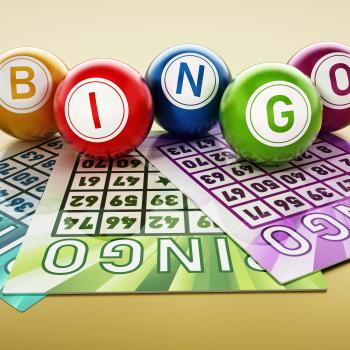Developing Searching, Skimming, and Scanning Skills With Internet Bingo

- Preview |
- Standards |
- Resources & Preparation |
- Instructional Plan |
- Related Resources |
- Comments
Overview
Because the Internet contains a vast amount of resources and information, students must be able to weed quickly through sites to find the information they need. This lesson develops students' skills in Internet searching, skimming, and scanning through teacher modeling, think-alouds, and think-pair-share. In this lesson, students begin with a discussion and demonstration of skimming and scanning to find information on the Internet. Through a teacher-modeled activity, students learn how to use appropriate key terms to yield a manageable number of resources. Students then divide into groups of two to complete a bingo game, and during the course of the game, students will search a website to fill in a bingo board. A sample bingo board focusing on ancient Greece and Rome is included, but additional content area-related goals may be incorporated by changing the questions on the bingo board to match a particular topic.
From Theory to Practice
- Children's most common use of the Internet is to search for information.
- Students must develop skills, including speed and efficiency, to navigate the Internet to find information they seek.
- Teachers can help students develop media literacy skills by modeling and providing instruction in these skills.
Common Core Standards
This resource has been aligned to the Common Core State Standards for states in which they have been adopted. If a state does not appear in the drop-down, CCSS alignments are forthcoming.
State Standards
This lesson has been aligned to standards in the following states. If a state does not appear in the drop-down, standard alignments are not currently available for that state.
NCTE/IRA National Standards for the English Language Arts
- 1. Students read a wide range of print and nonprint texts to build an understanding of texts, of themselves, and of the cultures of the United States and the world; to acquire new information; to respond to the needs and demands of society and the workplace; and for personal fulfillment. Among these texts are fiction and nonfiction, classic and contemporary works.
- 3. Students apply a wide range of strategies to comprehend, interpret, evaluate, and appreciate texts. They draw on their prior experience, their interactions with other readers and writers, their knowledge of word meaning and of other texts, their word identification strategies, and their understanding of textual features (e.g., sound-letter correspondence, sentence structure, context, graphics).
- 8. Students use a variety of technological and information resources (e.g., libraries, databases, computer networks, video) to gather and synthesize information and to create and communicate knowledge.
- 11. Students participate as knowledgeable, reflective, creative, and critical members of a variety of literacy communities.
- 12. Students use spoken, written, and visual language to accomplish their own purposes (e.g., for learning, enjoyment, persuasion, and the exchange of information).
Materials and Technology
- Computers with Internet access (one computer per two students)
- Video projector or large-screen monitor
- Chalkboard or whiteboard
- Overhead transparencies and projector
- Stamping marker to indicate correct responses on student bingo boards
Printouts
Websites
Preparation
| 1. | Plan heterogeneous cooperative groups of two students per group. To meet the needs of English-language learners (ELLs), consider pairing them with classmates who share the same native language so they may converse in their primary language when necessary. |
| 2. | Make one copy of the Skim & Scan Bingo Board: Ancient Rome and Greece and the Skim & Scan Bingo Reflection and Self-Assessment for each student in your class. The focus of the sample game is on ancient Rome and Greece, but you can create your own bingo board to meet other state content area standards. |
| 3. | You will need one computer for each pair of students and may need to reserve your school's computer lab for Session 2. Arrange to have a demonstration computer with Internet access and either a video projector or a large-screen monitor available during Session 1. |
| 4. | Bookmark Odyssey Online: Rome: Daily Life on your demonstration computer. Bookmark Social Studies for Kids on the computers students will be using. |
| 5. | Make an overhead transparency of the Skim & Scan Bingo Answer Key: Ancient Rome and Greece. Review the Skim & Scan Bingo Answer Key With Links: Ancient Rome and Greece. You will want to familiarize yourself with the links where students find answers so you can help them as necessary when they play the game. |
Student Objectives
Students will
- Develop skill in selecting key terms by conducting Internet searches to find necessary information
- Develop skill in skimming and scanning by using websites to find information for a bingo game
- Understand the purposes of using skimming and scanning by practicing these skills in order to win a game
Session 1
| 1. | Seat students so they can view your computer screen. The use of a video projector or large-screen monitor is ideal for this step. |
||||||
| 2. | Introduce the skills of skimming (reading quickly to get the main idea of the text) and scanning (rapidly viewing the text in search of key terms, phrases, or information). Write the terms and their definitions on the chalkboard or whiteboard. You may choose to have students copy them into notebooks. |
||||||
| 3. | Navigate to Odyssey Online: Rome: Daily Life and spend about five minutes using a think-aloud to model both skimming and scanning. For instance, you might say the following:
Suppose I was doing the report on what life was like in ancient Rome, and I came across this website. I don't want to read every word of every website that I find on the topic of ancient Rome, so I'd want to quickly decide whether this article would be helpful for my report. The first thing I would do is read the title and subheadings. (Read them aloud.) Now, I want to skim the article to find out if I think it will be helpful to read it all. I read the first paragraph to get a better idea of it. Read aloud the first paragraph and then continue to use a think-aloud approach to skim and scan through the rest of the article. |
||||||
| 4. | Lead a brief discussion to review the purposes of using skimming and scanning. Questions for discussion include:
|
||||||
| 5. | Discuss how to select key terms to use when conducting Internet searches. For example, tell students that you want to find out about swords that were used in ancient Greece. Display the Social Studies for Kids website and demonstrate how to use the search (make sure you click the radio button next to This Site and not The Web). Use a think-aloud approach and student input to work through the following steps:
|
||||||
| 6. | Have students suggest other facts about ancient Greece that a person might investigate through a search of the Social Studies for Kids website. Using a think-pair-share, have students suggest possible search terms to use. Experiment with their suggestions by searching for some of the terms. Discuss the outcome of each search. |
Sessions 2 and 3
Depending on how much time you allot for the game, it is possible to complete Sessions 2 and 3 as one session.
| 1. | Review the definitions and purposes of skimming and scanning and how to use the search tool on the Social Studies for Kids website. |
||||||||||||||
| 2. | Distribute the Skim & Scan Bingo Board: Ancient Rome and Greece to students and introduce directions to the game as follows:
|
||||||||||||||
| 3. | Students play the game. Circulate to assist students and check responses. Using a stamping marker, stamp each correct response. This will make it easier to check for bingos as the game progresses. |
||||||||||||||
| 4. | When time is up or when the first team fills in the entire board, stop the game and use the overhead transparency of the Skim & Scan Bingo Answer Key: Ancient Rome and Greece to review the answers to the bingo questions. You might also choose to refer to the Skim & Scan Bingo Answer Key With Links: Ancient Rome and Greece as necessary. It is recommended that the review of the answers be conducted with students seated at their regular desks. |
||||||||||||||
| 5. | Talk about the activity and what students learned. Discuss difficulties teams experienced when searching for answers and ask students what they did to overcome these difficulties. Ask students how they might use the skills they practiced in other contexts. |
Extensions
Have students create new bingo boards using other websites and topics.
Student Assessment / Reflections
In addition to taking notes and assessing student responses to the game prompts, a Skim & Scan Bingo Reflection and Self-Assessment is provided for informal assessment purposes. Students should independently complete this handout. Use the results as a springboard for a future discussion or as a tool to determine which students may need extra practice with searching, skimming, and scanning online.
